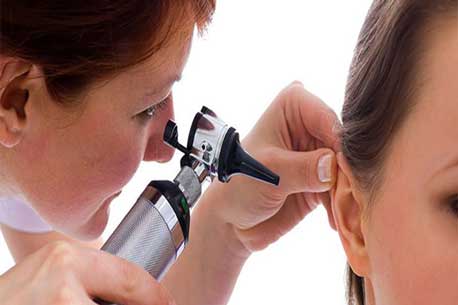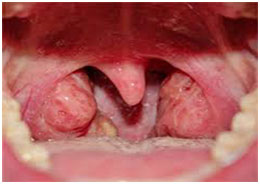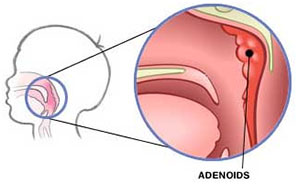



Rhinoplasty is the surgery of the nose shape with an aim to suit it with the rest of the face. It is correction of shape of the nose either for aesthetic reason or nasal deformitiesReconstructive Rhinoplasty is not a coded one like cosmetic rhinoplasty. The surgery requires technical gestures based on the clinical cases. If the above symptoms are found , there may be a need to undergo tonsillectomy surgery pending further evaluation , whereby tonsils are removed from both sides. Tonsils are very much a removable tissue, and are removed intraorallyi.e via mouth
In case the above symptoms are present , there may be a need to undergo adenoidectomy surgery pending further evaluation. At our centre adenoidectomy is carried out under endoscopic vision and with the help of a special blade called as microdebrider ; among the many techniques of adenoid removal, the above technique has been found to be superior to all others, as complete removal of adenoid tissue is ensured without the risk of damage to any vital structures and any chances of recurrence.

Rhinoplasty is the surgery of the nose shape with an aim to suit it with the rest of the face. It is correction of shape of the nose either for aesthetic reason or nasal deformities
Types Of Rhinoplasty
Reconstructive Rhinoloplasty

Reconstructive Rhinoplasty is not a coded one like cosmetic rhinoplasty. The surgery requires technical gestures based on the clinical cases.
A Reconstructive Rhinoplasty is done dues to causes like:
Types of Reconstructive Rhinoplasty
Anatomy Of Tonsils And Adenoids


Tonsils are a part of the immune system located in throat while adenoids are a similar tissue located in nasopharynx( part behind the nose). Both act as a first line of defence against microbe invasion of aerodigestive tract.
While performing this immunoprotective task, the se tissues by themselves may become a part of the disease process by becoming a site of infection themselves. Additionally adenoids by virtue of their location may further cause nasal obstruction leading to poor nasal breathing. Both conditions are more common in children .
Symptoms Of Tonsillitis
Tonsillectomy
If the above symptoms are found , there may be a need to undergo tonsillectomy surgery pending further evaluation , whereby tonsils are removed from both sides. Tonsils are very much a removable tissue, and are removed intraorallyi.e via mouth
Symptoms Of Adenoid Enlargement
Adenoidectomy
In case the above symptoms are present , there may be a need to undergo adenoidectomy surgery pending further evaluation. At our centre adenoidectomy is carried out under endoscopic vision and with the help of a special blade called as microdebrider ; among the many techniques of adenoid removal, the above technique has been found to be superior to all others, as complete removal of adenoid tissue is ensured without the risk of damage to any vital structures and any chances of recurrence.
Moreover , often both the conditions are found to be coexisting in the same patient with children being most commonly affected and hence they must be diagnosed and treated to prevent further complications.
Growths And Conditions That May Be Treated By Skull Base Surgery :
Types Of Skull Base Surgery
Symptoms
The following symptoms are shown to indicate any abnormality in the skull base area. Symptoms will depend on the size, type, and location of the growth or abnormality :
Our department comprises of an Audiologist, Speech Therapist, & Hearing Aid Consultant. For diagnosis and management of hearing disorders we have
Diagnostic Audiological Tests
Digital Hearing Aids And Assistive Listening Devices
We offer hearing aids and assistive listening devices to fit each patient’s particular need.
Introduction To Cochlear Implant
Speech and Hearing is the most effective method of communication, it is a unique boon to a human being. Unfortunately some are born deaf called ‘Prelingual Deaf’. Those born with normal hearing but have lost hearing after acquiring speech are called as “Postlingual deaf”. Deafness identified early helps addressing the challenges in rehabilitation of a Deaf child successfully. A cochlear implant is an established, effective and long-term hearing solution for people with moderate to profound hearing loss. Unlike traditional hearing aids that amplify, or make sounds louder, a cochlear implant system can be a more effective hearing solution for certain people. A cochlear implant is capable of directly stimulating the cochlea hearing nerve, bypassing the damaged area of the hearing pathway. When it comes to effectively managing hearing loss, among other factors, the brand of ear implants has been shown to make a significant difference in the speech performance outcomes of post-linguistically deafened adults.
Why Such Aggressive Steps Towards Cochlear Implant Required: (Use It Now Or Lose It Permanently)
The cost of implant being the biggest constraint we are unable to do implant in the huge no. of deaf and mute children. As a social obligation we have decided to help these children by raising funds for them in our public Charitable trust, HCP ENT Charitable Trust. So please donate generously which shall be a highly appreciable contribution to this noble cause.
| Minimum | Maximum | |||
|---|---|---|---|---|
| INR | USD | INR | USD | |
| Septoplasty | 126000 | 1836.58 | 182000 | 2652.83 |
| Tympanoplasty | 126000 | 1836.58 | 182000 | 2652.83 |
Dr. Sanjay Helale, is an eminent Consultant ENT and Head and Neck Surgeon with 18 years of experience in the field. He is also a very well known Laser Surgeon. He has worked at various Hospitals in Mumbai and is currently the Head of Department of ENT at Kohinoor Hospital and Fauzia Hospital, Kurla (W), Mumbai. He is also a Visiting Honorary ENT Surgeon at Kurla Bhabha Municipal Hospital, Mumbai. He has been invited as a guest faculty in various conferences and seminars being a TOP ENT Surgeon in Mumbai. His main areas of interests are Micro Ear surgery, Phono-surgery, Endoscopic Sinus Surgery and Head & Neck Surgery, Skull Base Surgery, Cochlear Implant Surgery and Sleep Apnea Surgery. Apart from his clinical work, he is also attached to various charity organizations. His varied practice across various hospitals reaching a huge spectrum of patients cases makes him a Top ENT Surgeon in Mumbai.